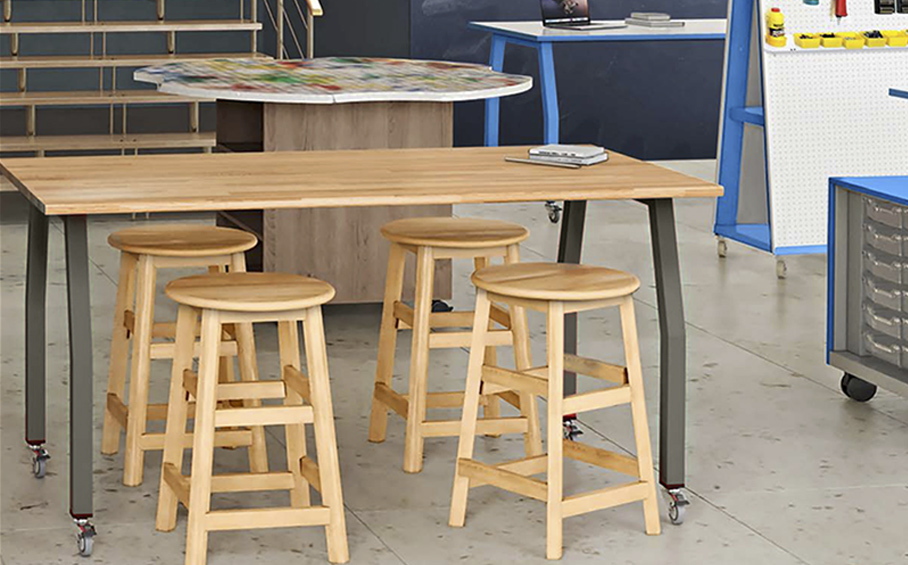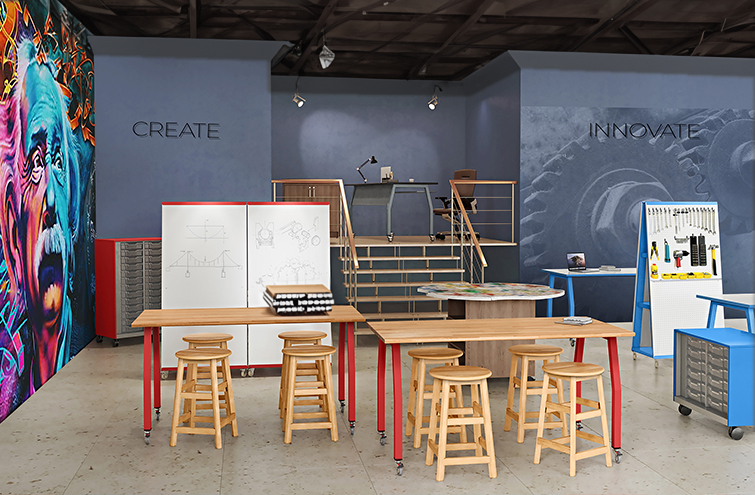In today’s rapidly evolving educational landscape, AI programming classrooms have emerged as a critical subject for preparing students for future careers. As schools increasingly incorporate artificial intelligence and coding into their curriculum, the physical learning environment plays a crucial role in supporting effective instruction. The right classroom furniture and layout can significantly enhance student engagement, collaboration, and learning outcomes in AI programming education.
Understanding the Modern AI Programming Classrooms
The traditional computer lab with rows of fixed desktop computers is no longer adequate for teaching the dynamic, collaborative skills required in AI programming. Today’s AI programming classroom needs to support various learning modes—from direct instruction to collaborative problem-solving to independent coding practice.
An effective AI programming learning environment facilitates:
- Active learning through hands-on experimentation with coding and AI concepts
- Collaboration between students working on complex programming projects
- Flexibility to quickly transition between different teaching and learning approaches
- Technology integration that supports both hardware and software requirements
- Comfort and ergonomics for extended periods of focused work
Let’s explore the essential furniture components, classroom design considerations, and pedagogical approaches that create optimal AI programming learning spaces.
Essential Furniture Components for AI Programming Classrooms
Variable-Height Workstations
AI programming education often requires students to alternate between various activities—typing code, sketching algorithms, building physical computing projects, or engaging in discussions. multi-height desks accommodate these diverse needs and support ergonomic health during extended computer work.
Look for workstations with:
- Height adjustment capabilities
- Ample surface area for computers plus additional materials
- Durable construction to withstand daily use and technology weight
- Cable management solutions to prevent trip hazards and equipment damage
Ergonomic Seating Options
Programming instruction often involves extended periods of seated work. Ergonomic classroom seating helps prevent discomfort and supports student focus during complex coding tasks.
Consider these seating solutions:
- Adjustable chairs with proper lumbar support
- Alternative seating options like stability balls or standing desks for varied postures
- Mobile classroom chairs that easily reconfigures for different activities
- Durable materials that withstand constant classroom use
Collaborative Table Configurations
AI programming thrives on collaboration, with pair programming and team projects being standard practice in industry settings. Classroom furniture should facilitate this collaborative approach.
Effective collaborative furniture includes:
- Modular tables or desks for students that can join together for group work
- Writable surfaces for algorithm sketching and problem-solving
- Mobile activity tables with locking casters for quick reconfiguration
- Varied shapes (trapezoid, curved, etc.) that support different group sizes
Mobile Storage Solutions
AI programming classes often utilize various resources beyond computers—micro-controllers, robotics components, sensor kits, and project materials. Accessible, organized storage keeps these valuable supplies secure and readily available.
Look for storage options with:
- Mobile carts that bring resources to student workstations
- Transparent containers, like totes, to easily identify contents
- Lockable cabinets for expensive equipment
- Adjustable shelving to accommodate different-sized components
Flexible Power and Data Access
Perhaps the most critical infrastructure consideration for AI programming classrooms is reliable, accessible power and data connectivity.
Essential power features include:
- Abundant power outlets at workstations
- Cable management systems to prevent tripping hazards
- Floor outlets for centrally located furniture arrangements
- USB charging capabilities for multiple devices
- High-speed network connectivity throughout the space
Classroom Layout Considerations
The physical arrangement of an AI programming classroom significantly impacts teaching effectiveness and student learning. Strategic zones within the classroom support different modes of instruction and learning activities.
Direct Instruction Zone
Even technology-focused classrooms need space for teacher-led instruction. This area typically includes:
- Interactive display or whiteboard visible to all students
- Teacher workstation with demonstration capabilities
- Seating arranged for clear sightlines to instructional displays
- Space for students to gather for direct instruction when needed
Collaborative Coding Spaces
Dedicated areas for team programming projects encourage the collaborative problem-solving essential to AI development. These spaces should include:
- Grouped workstations that allow screen sharing
- Whiteboards or writable surfaces for planning and algorithm design
- Adequate space for students to gather around a single computer when needed
- Semi-private arrangements that contain collaborative conversations
Individual Work Areas
Deep focus time is also essential in programming education. Individual workspaces support:
- Independent practice with new programming concepts
- Assessment activities
- Debugging and problem-solving
- Portfolio development work
Equipment Storage and Distribution
Organized storage and distribution systems for technology keep valuable resources secure while making them accessible when needed:
- Centralized charging stations for mobile devices
- Secure storage for robotics equipment and components
- Check-out systems for specialized equipment
- Visible inventory management
Presentation Spaces
Sharing and discussing code is an important part of the learning process. Presentation areas support:
- Student demonstrations of completed projects
- Code reviews among peers
- Display of exemplary work
- Industry or guest presenter visits
Pedagogical Approaches for AI Programming Education
The physical environment should support research-backed teaching approaches for programming and AI education. Here are key pedagogical strategies and how classroom design can enhance them:
Project-Based Learning
Project-based learning provides authentic context for AI programming skills. Classroom features that support this approach include:
- Flexible workspaces that adapt to different project needs
- Storage for long-term projects
- Display areas for project artifacts and documentation
- Spaces for project planning and team meetings
Pair Programming Techniques
Pair programming—where two students work together at one computer—is a proven practice in coding education. This approach is supported by:
- Workstations sized to comfortably accommodate two students
- Seating arrangements that allow easy viewing of shared screens
- Whiteboards for collaborative planning before coding
- Acoustic considerations to manage conversation noise
Design Thinking Approaches
Design thinking processes help students develop user-centered AI applications. This approach benefits from:
- Reconfigurable spaces for different design thinking phases
- Materials for prototyping and testing
- Surfaces for displaying user research and requirements
- Areas for user testing and feedback collection
Collaborative Problem-Solving
Complex AI problems often require group problem-solving. Classroom design facilitates this through:
- Breakout spaces for small group discussions
- Vertical writing surfaces for shared problem analysis
- Large-format displays for examining code together
- Comfortable spaces that encourage extended collaboration sessions
Differentiated Instruction Methods
Students learn programming at different paces and have varying interests. Classroom environments can support differentiation through:
- Station-based learning setups
- Quiet zones for students who need fewer distractions
- Advanced resource areas for students ready for extension activities
- Accessible design that accommodates all learners
Implementation Examples: AI Programming Classrooms in Action
Elementary Level: Introductory Coding Space
Younger students benefit from flexible spaces that transition easily between unplugged activities and basic programming. An effective elementary AI programming classroom might feature:
- Mobile furniture that clears space for unplugged algorithm activities
- Robot navigation spaces for introductory programming concepts
- Collaborative tables for small group coding experiences
- Comfortable reading areas for computational thinking literature
Middle School: Transitional Technology Lab
Middle school students begin more formal programming instruction while still needing movement and collaboration. These classrooms often include:
- Height-adjustable workstations that accommodate growing students
- Makerspaces integrated with programming areas
- Defined zones for different activities within a single period
- Varied seating options to accommodate physical energy and focus needs
High School: Professional Development Environment
High school programming environments often mirror professional settings to prepare students for careers or higher education. These spaces typically feature:
- Professional-grade workstations with industry-standard hardware
- Dedicated project team areas
- Conference spaces for client meetings on applied projects
- Specialized equipment for AI applications (robotics, computer vision systems, etc.)
Future-Proofing: Creating Adaptable AI Programming Spaces
Technology and teaching methods evolve rapidly in the AI education space. Future-proof your classroom by considering:
Flexible Infrastructure
- Modular furniture systems that can be reconfigured as needs change
- Mobile technology solutions rather than permanent installations
- Accessible power and data throughout the space, not just at fixed points
- Multipurpose spaces that can adapt to emerging technologies
Sustainable Materials
- Durable furniture that withstands constant use and reconfiguration
- Environmentally responsible materials that maintain healthy indoor air quality
- Repairable components that extend furniture lifetime
- Materials that can be recycled at end-of-life
Adaptable Technology Integration
- Furniture designed to accommodate various device types and sizes
- Infrastructure that supports increasing power and connectivity demands
- Spaces that can incorporate emerging technologies (AR/VR, advanced robotics, etc.)
- Flexible mounting solutions for changing display and interaction technologies
Getting Started: Planning Your AI Programming Classroom
Ready to create or update your AI programming learning environment? Consider these steps:
- Assess current and future curriculum needs by consulting with teachers and IT staff
- Observe existing spaces to identify pain points and opportunities
- Engage students in the design process to understand their learning preferences
- Start with pilot spaces before full implementation
- Plan for professional development to help teachers maximize the new environment
- Develop maintenance protocols to ensure longevity of furniture and equipment
Conclusion: Investing in AI Education Environments
Creating effective AI programming classrooms requires thoughtful investment in appropriate furniture, strategic layout design, and alignment with effective teaching practices. When the physical environment supports both the technical requirements and the pedagogical approaches of AI education, students develop the skills, creativity, and collaborative abilities needed for future success.
The classroom environment becomes a powerful teaching tool itself—communicating the professional, innovative nature of AI programming and inviting students to see themselves as capable developers and designers of future technologies.
As schools prepare students for an AI-integrated world, the learning spaces we create today will shape how they engage with technology tomorrow. By designing flexible, collaborative, and well-equipped AI programming classrooms, we provide the foundation for future innovation.
Allied USA School Furniture specializes in designing and manufacturing innovative furniture solutions for technology-rich learning environments. Contact our educational consultants to explore how we can help create your ideal AI programming classroom.








